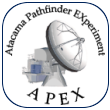SHeFI Calibration Plan
Introduction
In order to ensure a proper calibration for SHFI data, we have set up a calibration plan for the 230 and 345 GHz bands. Within this plan several calibration-relevant parameters are monitored regularly. On this page, we give an overview of the observations and analysis, and provide links to the calibration pages of the different SHeFI bands.
Calibration plan main pages:
APEX-1 (230 GHz)
|
APEX-2 (345 GHz)
Calibration plan search engine & database interface
Intensity calibration stability
By observing strong (non-masing) spectral lines in several sources over the whole frequency range accessible by our receivers, we provide a intensity reference for scientific observations. These measurements are performed in regular intervals, at least once per observing block. This way we are able to monitor the calibration stability as a function of time and frequency. The observing and reduction routines for these measurements are highly automized.
For each receiver band, the results are presented on an overview page which contains estimated line parameters, a representative spectrum, and a link to a monitoring page for each source-line combination. The monitoring page contains line parameters and the spectrum for each date this combination has been observed.
| Intensity monitoring overview pages: | • APEX-1 (230 GHz) |
| • APEX-2 (345 GHz) |
Information about SHeFI Calibration Correction Factors for observation done between 2014/02/01 and 2014/06/13.
Sideband response
Ideally the intensities obtained for a line should be independent of the sideband to which the receiver is tuned during the observations. Deviations from this could indicate problems in the receiver, in the calibrator software, or in the atmospheric model used for calibration. In order to detect such problems and to optimize the calibration stability, we monitor for several sources some lines over the frequency band, which are regularly observed in USB and LSB tunings. The following table gives an overview over these lines and their frequencies:
| APEX-1 (230 GHz) | 12CO(2-1) | CS(5-4) | |
|---|---|---|---|
| 230.538 GHz | 244.936 GHz | ||
| APEX-2 (345 GHz) | OCS340 | 13CO(3-2) | 12CO(3-2) |
| 304.069 GHz | 330.588 GHz | 345.796 GHz |
| Sideband response monitoring results: | • APEX-1 (230 GHz) |
| • APEX-2 (345 GHz) |
Sideband ratio
For line-rich sources, the data obtained during intensity monitoring can be analyzed to estimate the image band contamination. This has been done for various lines of Orion-KL with the old APEX-2A receiver. Since the SHFI SIS receivers are operated in single-sideband mode, this is no longer necessary. We have done this analysis on some occasions and found an image band rejection of 16 dB or more.
Frequency stability
For narrow-line sources the regular observations can also be used to determine the centre velocity and line width of selected spectral lines. In this way we are able to monitor the stability of our complete LO system, from Doppler shift calculation to backend properties. Through the line-width monitoring we can detect any extra broadening, e.g. because of LO frequency fluctuations.
For the source WB947 we monitor the 12CO(3-2), 13CO(3-2), 12CO(2-1), and 13CO(2-1) line, in USB and LSB. For each date the peak velocity and line width are estimated by a Gaussian fit. The results can be found on the main monitoring pages.
Focus behaviour
In order to monitor the behaviour of the focus offsets of the subreflector, the focus observations performed during science projects or technical time are analyzed for all receivers.




